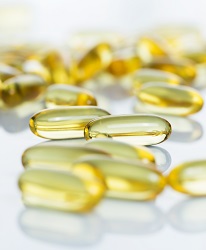
Vitamin E is a fat-soluble vitamin that is also an antioxidant. It supports immune function and can prevent clots from forming in arteries. So how much do dogs need, and should we be supplementing?
I’ve had clients ask how to determine how much vitamin E their dog needs, but if we are using the science to answer this, which is what I do, it’s not a straight-forward answer. It has at least two parts. One part is based on the size of your dog, and another part is based on the amount of polyunsaturated fatty acids (PUFA), such as fish oil, in the diet. Of course if you’re my client, an appropriate amount of vitamin E to supplement for your dog will always be on the recipe report I provide, so do not worry about learning the math behind it, unless you want to! Some people love it, and for some people it makes their eyes glaze over. (I do not judge either group!) If you’re in the first group, continue reading.
If you are adding fish oil to a commercial dry dog food, and not a home-prepared diet, skip to Step 2!
First, your dog has a need for a certain amount of vitamin E (d-alpha-tocopherol) based on their weight, and there’s an equation for that below (from the NRC – National Research Council). Second, with every gram of PUFA in the diet the need for vitamin E increases. Let’s use an actual example, because if you’re like me, it’s easier to learn by applying something, rather than just being given equations.
1. Vitamin E required based on the size of your dog:

Let’s say the dog in our example weighs 72 lb (32.7 kg).
The equation for how many milligrams of vitamin E a dog needs, is:
BWkg^0.75
That’s the dog’s body weight in kg to the power of 0.75.
(To convert lb to kg we divide by 2.2.)
Using the xy button on a scientific calculator we find that 32.7^0.75 = 13.67 mg of vitamin E. This is what’s called the RA (Recommended Allowance) by the NRC. If you are a client of mine, this is the amount you see in the “requirement” column of the recipe report.
So that’s the first part, now on to the second.
2. Vitamin E required for the amount of PUFA in the diet:

For every gram of polyunsaturated fatty acids (PUFA) in the diet the need for vitamin E increases by 10 IU. This is because of vitamin E’s antioxidant properties which protect PUFA from oxidation. Typical PUFA in a homemade recipe might be things like fish oil (for omega 3) and wheatgerm oil (for omega 6—also important). It’s important to note this applies to fish oil added to kibble as well!
Let’s pretend the 72 lb dog in our example above is getting a therapeutic dose of fish oil that contains 3 grams of PUFA, and is also getting 5 grams of wheatgerm oil, which contains 3 grams total PUFA (the other 2 g are monounsaturated and saturated fats). The key here is to count the polyunsaturated fatty acids – we have 6 grams in this example. So, 6 g x 10 IU = 60 IU.
But wait, we were talking about the units as mg in Step 1, and now we’re talking about IU. We need yet another unit conversion. To go from IU to mg (for vitamin E in the form of d-alpha-tocopherol) we multiply by 0.67.
60 IU x 0.67 = 40.2 mg of vitamin E.
More fat-soluble vitamin unit conversions at this link: https://dietarysupplementdatabase.usda.nih.gov/Conversions.php
3. Combine the two amounts of vitamin E and include a buffer:
Those formulating dog diets will almost always add a third step.
Keep in mind, we’ve been discussing how much vitamin E is needed to just reach the amount required for this particular 72 lb dog’s diet. As with several other nutrients, it’s a good idea to add a little bit of a buffer. Unlike vitamin E, some nutrients, such as vitamins A and D, have a “safe upper limit” established by the NRC (National Research Council). Vitamin E is generally considered very safe and there has been no safe upper limit defined. However, it is a fat-soluble vitamin which is stored in the body, and it’s not something that I think should be given in excess.
Adding the amounts from steps 1 and 2 in our example we get, 13.67 mg + 40.2 mg = 53.87 mg
For many nutrients, including vitamin E, I’m comfortable with increasing to a least 130% of what’s needed based on the NRC guidelines (used in steps 1 and 2). So, that would bring the 53.87 mg to about 70 mg, which is about 104 IU.
Other experienced animal nutrition professionals recommend a much higher buffer amount of vitamin E, so I do not doubt that it could safely go higher. How high is the question. The safe upper limit of vitamin D is about 600% of the RA (Recommended Allowance), and the safe upper limit of vitamin A is even higher (not that I would ever want to go all the way up to the limit for any extended period of time). Are these other fat-soluble vitamins an indication of how much more vitamin E we can give? I don’t know; I think more research would be needed to answer that.
Don’t be surprised if I revisit this topic in the future!
Additional reading: If you enjoyed this topic, Mary Straus has some helpful information about vitamin E on her DogAware site. http://www.dogaware.com/diet/supplements.html#vitE